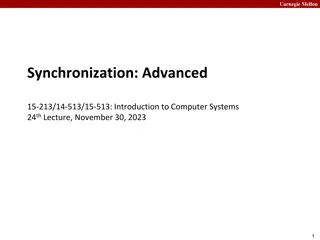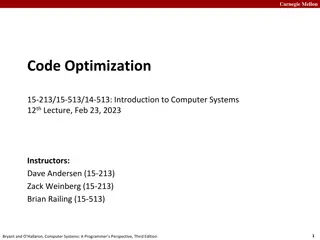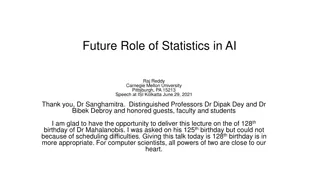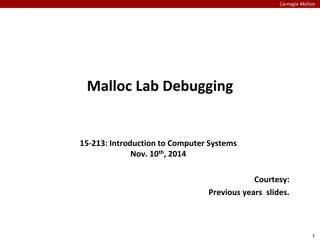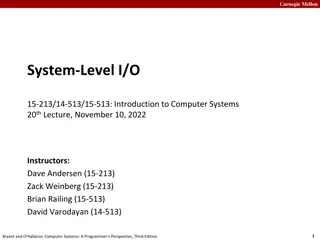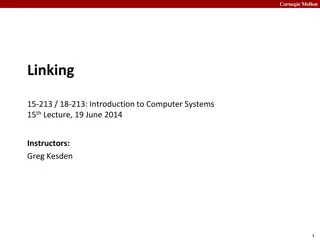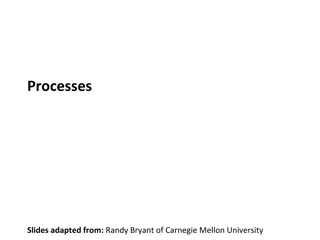Understanding Web Basics at Carnegie Mellon University
Carnegie Mellon University's recitation covers various aspects of web systems including telnet/cURL demonstrations, the inner workings of the web, networking basics, and string manipulation in C. The session explores client-server interactions, manual HTTP requests, and the use of cURL for building valid HTTP requests and generating proxy requests. Students learn about sequential servers, handling text pages with embedded styles, and more.
Download Presentation

Please find below an Image/Link to download the presentation.
The content on the website is provided AS IS for your information and personal use only. It may not be sold, licensed, or shared on other websites without obtaining consent from the author. Download presentation by click this link. If you encounter any issues during the download, it is possible that the publisher has removed the file from their server.
E N D
Presentation Transcript
Carnegie Mellon Proxy Web & Concurrency 15/18-213: Introduction to Computer Systems Recitation 13 Rohith Jagannathan April 13th, 2015 1
Carnegie Mellon Outline Getting content on the web: Telnet/cURL Demo How the web really works Networking Basics Proxy Due Tuesday, April 28th No late days No partners this year String Manipulation in C 2
Carnegie Mellon The Web in a Textbook Client request page, server provides, transaction done. Web client (browser) Web server A sequential server can handle this. We just need to serve one page at a time. This works great for simple text pages with embedded styles. 3
Carnegie Mellon Telnet/Curl Demo Telnet Interactive remote shell like ssh without security Must build HTTP request manually This can be useful if you want to test response to malformed headers [rjaganna@makoshark ~]% telnet www.cmu.edu 80 Trying 128.2.42.52... Connected to WWW-CMU-PROD-VIP.ANDREW.cmu.edu (128.2.42.52). Escape character is '^]'. GET http://www.cmu.edu/ HTTP/1.0 HTTP/1.1 301 Moved Permanently Date: Sat, 11 Apr 2015 06:54:39 GMT Server: Apache/1.3.42 (Unix) mod_gzip/1.3.26.1a mod_pubcookie/3.3.4a mod_ssl/2.8.31 OpenSSL/0.9.8e- fips-rhel5 Location: http://www.cmu.edu/index.shtml Connection: close Content-Type: text/html; charset=iso-8859-1 <!DOCTYPE HTML PUBLIC "-//IETF//DTD HTML 2.0//EN"> <HTML><HEAD> <TITLE>301 Moved Permanently</TITLE> </HEAD><BODY> <H1>Moved Permanently</H1> The document has moved <A HREF="http://www.cmu.edu/index.shtml">here</A>.<P> <HR> <ADDRESS>Apache/1.3.42 Server at <A HREF="mailto:webmaster@andrew.cmu.edu">www.cmu.edu</A> Port 80</ADDRESS> </BODY></HTML> Connection closed by foreign host. 4
Carnegie Mellon Telnet/cURL Demo cURL URL transfer library with a command line program Builds valid HTTP requests for you! [rjaganna@makoshark ~]% curl http://www.cmu.edu/ <!DOCTYPE HTML PUBLIC "-//IETF//DTD HTML 2.0//EN"> <HTML><HEAD> <TITLE>301 Moved Permanently</TITLE> </HEAD><BODY> <H1>Moved Permanently</H1> The document has moved <A HREF="http://www.cmu.edu/index.shtml">here</A>.<P> <HR> <ADDRESS>Apache/1.3.42 Server at <A HREF="mailto:webmaster@andrew.cmu.edu">www.cmu.edu</A> Port 80</ADDRESS> </BODY></HTML> Can also be used to generate HTTP proxy requests: [rjaganna@makoshark ~]% curl --proxy lemonshark.ics.cs.cmu.edu:3092 http://www.cmu.edu/ <!DOCTYPE HTML PUBLIC "-//IETF//DTD HTML 2.0//EN"> <HTML><HEAD> <TITLE>301 Moved Permanently</TITLE> </HEAD><BODY> <H1>Moved Permanently</H1> The document has moved <A HREF="http://www.cmu.edu/index.shtml">here</A>.<P> <HR> <ADDRESS>Apache/1.3.42 Server at <A HREF="mailto:webmaster@andrew.cmu.edu">www.cmu.edu</A> Port 80</ADDRESS> </BODY></HTML> 5
Carnegie Mellon How the Web Really Works In reality, a single HTML page today may depend on 10s or 100s of support files (images, stylesheets, scripts, etc.) Builds a good argument for concurrent servers Just to load a single modern webpage, the client would have to wait for 10s of back-to-back request I/O is likely slower than processing, so back Caching is simpler if done in pieces rather than whole page If only part of the page changes, no need to fetch old parts again Each object (image, stylesheet, script) already has a unique URL that can be used as a key 6
Carnegie Mellon How the Web Really Works Excerpt from www.cmu.edu/index.html: <html lang="en" xml:lang="en" xmlns="http://www.w3.org/1999/xhtml"> <head> ... <link href="homecss/cmu.css" rel="stylesheet" type="text/css"/> <link href="homecss/cmu-new.css" rel="stylesheet" type="text/css"/> <link href="homecss/cmu-new-print.css" media="print" rel="stylesheet" type="text/css"/> <link href="http://www.cmu.edu/RSS/stories.rss" rel="alternate" title="Carnegie Mellon Homepage Stories" type="application/rss+xml"/> ... <script language="JavaScript" src="js/dojo.js" type="text/javascript"></script> <script language="JavaScript" src="js/scripts.js" type="text/javascript"></script> <script language="javascript" src="js/jquery.js" type="text/javascript"></script> <script language="javascript" src="js/homepage.js" type="text/javascript"></script> <script language="javascript" src="js/app_ad.js" type="text/javascript"></script> ... <title>Carnegie Mellon University | CMU</title> </head> <body> ... 7
Carnegie Mellon Sequential Proxy 8
Carnegie Mellon Sequential Proxy Note the sloped shape of when requests finish Although many requests are made at once, the proxy does not accept a new job until it finishes the current one Requests are made in batches. This results from how HTML is structured as files that reference other files. Compared to the concurrent example (next), this page takes a long time to load with just static content 9
Carnegie Mellon Concurrent Proxy 10
Carnegie Mellon Concurrent Proxy Now, we see much less purple (waiting), and less time spent overall. Notice how multiple green (receiving) blocks overlap in time Our proxy has multiple connections open to the browser to handle several tasks at once 11
Carnegie Mellon How the Web Really Works A note on AJAX (and XMLHttpRequests) Normally, a browser will make the initial page request then request any supporting files And XMLHttpRequest is simply a request from the page once it has been loaded & the scripts are running The distinction does not matter on the server side everything is an HTTP Request 12
Carnegie Mellon Outline Getting content on the web: Telnet/cURL Demo How the web really works Networking Basics Proxy Due Tuesday, April 28th No late days No partners this year String Manipulation in C 13
Carnegie Mellon Sockets What is a socket? To an application, a socket is a file descriptor that lets the application read/write from/to the network (all Unix I/O devices, including networks, are modeled as files) Clients and servers communicate with each other by reading from and writing to socket descriptors The main difference between regular file I/O and socket I/O is how the application opens the socket descriptors 14
Carnegie Mellon Overview of the Sockets Interface Client Server getaddrinfo getaddrinfo socket socket open_listenfd open_clientfd bind listen Connection request connect accept rio_writen rio_readlineb Client / Server Session Await connection request from next client rio_readlineb rio_writen EOF rio_readlineb close close 15
Carnegie Mellon Host and Service Conversion: getaddrinfo getaddrinfois the modern way to convert string representations of host, ports, and service names to socket address structures. Replaces obsolete gethostbyname - unsafe because it returns a pointer to a static variable Advantages: Reentrant (can be safely used by threaded programs). Allows us to write portable protocol-independent code(IPv4 and IPv6) Given host and service, getaddrinfo returns result that points to a linked list of addrinfo structs, each pointing to socket address struct, which contains arguments for sockets APIs. getnameinfo is the inverse of getaddrinfo, converting a socket address to the corresponding host and service. 16
Carnegie Mellon Sockets API int socket(int domain, int type, int protocol); Create a file descriptor for network communication used by both clients and servers int sock_fd = socket(PF_INET, SOCK_STREAM, IPPROTO_TCP); One socket can be used for two-way communication int bind(int socket, const struct sockaddr *address, socklen_t address_len); Associate a socket with an IP address and port number used by servers struct sockaddr_in sockaddr family, address, port 17
Carnegie Mellon Sockets API int listen(int socket, int backlog); socket: socket to listen on used by servers backlog: maximum number of waiting connections err = listen(sock_fd, MAX_WAITING_CONNECTIONS); int accept(int socket, struct sockaddr *address, socklen_t *address_len); used by servers socket: socket to listen on address: pointer to sockaddr struct to hold client information after accept returns return: file descriptor 18
Carnegie Mellon Sockets API int connect(int socket, struct sockaddr *address, socklen_t address_len); attempt to connect to the specified IP address and port described in address used by clients int close(int fd); used by both clients and servers (also used for file I/O) fd: socket fd to close 19
Carnegie Mellon Sockets API ssize_t read(int fd, void *buf, size_t nbyte); used by both clients and servers (also used for file I/O) fd: (socket) fd to read from buf: buffer to read into nbytes: buf length ssize_t write(int fd, void *buf, size_t nbyte); used by both clients and servers (also used for file I/O) fd: (socket) fd to write to buf: buffer to write nbytes: buf length 20
Carnegie Mellon Outline Getting content on the web: Telnet/cURL Demo How the web really works Networking Basics Proxy Due Tuesday, April 28th No late days No partners this year String Manipulation in C 21
Carnegie Mellon Proxy - Functionality Should work on vast majority of sites Reddit, Vimeo, CNN, NY Times, etc. Some features of sites which require the POST operation (sending data to the website), will not work Logging in to websites, sending Facebook message HTTPS is not expected to work Google, YouTube (and some other popular websites) now try to push users to HTTPs by default; watch out for that Cache previous requests Use LRU eviction policy Must allow for concurrent reads while maintaining consistency Details in write up 22
Carnegie Mellon Proxy - Functionality Why a multi-threaded cache? Sequential cache would bottleneck parallel proxy Multiple threads can read cached content safely Search cache for the right data and return it Two threads can read from the same cache block But what about writing content? Overwrite block while another thread reading? Two threads writing to same cache block? 23
Carnegie Mellon Proxy - How Proxies are a bit special - they are a server and a client at the same time. They take a request from one computer (acting as the server), and make it on their behalf (as the client). Ultimately, the control flow of your program will look like a server, but will have to act as a client to complete the request Start small Grab yourself a copy of the echo server (pg. 910) and client (pg. 909) in the book Also review the tiny.c basic web server code to see how to deal with HTTP headers Note that tiny.c ignores these; you may not 24
Carnegie Mellon Proxy - How What you end up with will resemble: Client socket address 128.2.194.242:51213 Server socket address 208.216.181.15:80 Server (port 80) Client Proxy Proxy server socket address 128.2.194.34:15213 Proxy client socket address 128.2.194.34:52943 25
Carnegie Mellon Summary Step 1: Sequential Proxy Works great for simple text pages with embedded styles Step 2: Concurrent Proxy multi-threading Step 3 : Cache Web Objects Cache individual objects, not the whole page Use an LRU eviction policy Your caching system must allow for concurrent reads while maintaining consistency. Concurrency? Shared Resource? 26
Carnegie Mellon Proxy Testing & Grading New: Autograder ./driver.sh will run the same tests as autolab: Ability to pull basic web pages from a server Handle a (concurrent) request while another request is still pending Fetch a web page again from your cache after the server has been stopped This should help answer the question is this what my proxy is supposed to do? Please don t use this grader to definitively test your proxy; there are many things not tested here 27
Carnegie Mellon Proxy Testing & Grading Test your proxy liberally The web is full of special cases that want to break your proxy Generate a port for yourself with ./port-for-user.pl [andrewid] Generate more ports for web servers and such with ./free-port.sh Consider using your andrew web space (~/www) to host test files You have to visit https://www.andrew.cmu.edu/server/publish.html to publish your folder to the public server Create a handin file with make handin Will create a tar file for you with the contents of your proxylab- handin folder 28
Carnegie Mellon Tips: Version Control What is Git? Version control software Easily roll back to previous version if needed Already installed on Andrew machines Set up a repo on GitHub, BitBucket, or AFS Make sure only can access it! Using Git git pull git add . git commit -m I changed something git push 29
Carnegie Mellon Outline Getting content on the web: Telnet/cURL Demo How the web really works Networking Basics Proxy Due Tuesday, April 28th No late days No partners this year String Manipulation in C 30
Carnegie Mellon String manipulation in C sscanf: Read input in specific format int sscanf(const char *str, const char *format, ); Example: buf = 213 is awesome // Read integer and string separated by white space from buffer buf // into passed variables ret = sscanf(buf, %d %s %s , &course, str1, str2); This results in: course = 213, str1 = is, str2 = awesome, ret = 3 31
Carnegie Mellon String manipulation (cont) sprintf: Write input into buffer in specific format int sprintf(char *str, const char *format, ); Example: buf[100]; str = 213 is awesome // Build the string in double quotes ( ) using the passed arguments // and write to buffer buf sprintf(buf, String (%s) is of length %d , str, strlen(str)); This results in: buf = String (213 is awesome) is of length 14 32
Carnegie Mellon String manipulation (cont) Other useful string manipulation functions: strcmp, strncmp, strncasecmp strstr strlen strcpy, strncpy 33
Carnegie Mellon Aside: Setting up Firefox to use a proxy You may use any browser, but we ll be grading with Firefox Preferences > Advanced > Network > Settings (under Connection) Check Use this proxy for all protocols or your proxy will appear to work for HTTPS traffic. 34
Carnegie Mellon Acknowledgements Slides derived from recitation slides of last 2 years by Shiva Hartaj Singh Dugal Ian Hartwig 35
Carnegie Mellon Questions? 36


